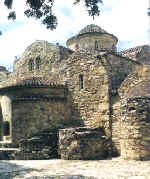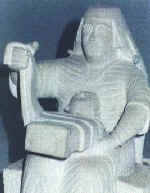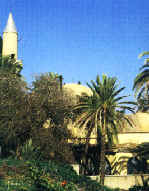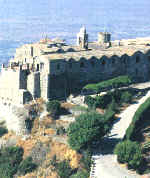|
|
Larnaka, a town with an easy-going pace, has strong links to the past. In the heart of modern Larnaka one finds remains of the ancient city-kingdom of Kition, reminiscent of its glorious days.
Mycenaean Greeks fortified the town with cyclopean walls in the 12th century, while Phoenicians founded a powerful kingdom here in 9th century. Kition is the birthplace of the philosopher “Zeno”, founder of Stoic School, and it is here that Saint Lazarus came to live after his resurrection.
In 18th century, it became a commercial center and the seat of European consulates. Delightful Palm Trees Promenade, its fort, and its old quarters give Larnaka its unique character. The nearby salt lake is a favorite stopover spot for thousands of migrant birds in winter; whilst on its edge in a tranquil setting stands a popular Muslim pilgrimage place.
The whole district of Larnaka has something special to offer the visitor, including Choirokoitia, the oldest Neolithic settlement on the island, Stavrovouni Monastery and the famous Church of Angeloktisti.

Panagia Angeloktisti Church
Places of Interest:
Bust Of Kimon
At the seafront promenade
Athenian General Kimon led 200 triremes in 450 BC to free Cyprus from Iranian. He died, while he was besieging Kition.
Larnaka District Archaeological Museum
Plateia Kalogreon, Tel: (04) 63 01 69
Interesting collection of finds from Larnaka area dating back from Neolithic Age to Roman period is shown.
Pierides Foundation Museum
Zinonos Kitieos 4, Tel: (04) 65 24 95
The oldest private museum in Cyprus, set up by Dimitrios Pierides (1811-1895). It houses ancient, medieval, Byzantine and more recent objects belonging to the Pierides family. A display case of Modern Greek and Cypriot sculptures could be seen in courtyard.
Larnaka Fort: Local Mediaeval Museum
Larnaka seafront
It was built in 1625 and was used as a prison in the first years of British rule. It houses District Mediaeval Museum. The fort is also used as Larnaka Municipal Cultural Center during summer.
Larnaka Municipal Cultural Center
Plateia Europis-Seafront promenade, Tel: (04) 65 88 48
Five old Larnaka Customs warehouses, built in colonial style (1881), have recently been renovated and turned into Larnaka Municipal Cultural Center. It houses Municipal Gallery and the only Paleontology Museum in Cyprus, where ancient fossilized remains of pygmy elephants and hippopotami that once lived on the island could be seen. The Center also has facilities for occasional exhibitions.
Agios Lazaros Church
Plateia Agiou Lazarou
Saint Lazarus is the patron saint of Larnaka. Kition became his second home after his resurrection by Christ and he lived here for another 30 years. Saints Barnabas and Mark ordained him Bishop of Kition.
In 9th century, Emperor Leo VI erected a magnificent church over his tomb. The church, one of the finest examples of Byzantine architecture in Cyprus, was faithfully restored in 17th century and the iconostasis is an excellent example of baroque woodcarving.
Visitors could see tomb of Saint Lazarus under the sanctuary and the ecclesiastical museum behind the church (Tel: (04) 65 24 89)
Eight days before Greek Orthodox Easter, the icon of Saint Lazarus is taken in procession through the streets of Larnaka.
Kition
Approximately 500 m Northeast of Archaeological Museum
It is one of the most important ancient city-kingdoms, with architectural remains dating back to 13th century BC. In about 1200 BC, Mycenaean Greeks rebuilt it and excavations have revealed cyclopean walls made of giant blocks of stone and a complex of five temples.
Kamares Aqueduct
Kamares area, on Larnaka-Lemesos road
A beautiful 18th century aqueduct, which was in use until 1930.
Municipal Museum Of Natural History
Leoforos Grigori Afxentiou, Tel: (04) 65 25 69
It is located within Larnaka Municipal Gardens and Museum has displays of rare insects, birds and animals of Cyprus.

Mosaic, 6th century AD
from Panagia Angeloktisti Church

Kostas Argyrou Museum
Out of City, Area 1:
Hala Sultan Tekesi
3 km West of Larnaka on the road to Kiti, passing Larnaka Airport
It was built in 1816 over the tomb of Umm Haram, allegedly a relative of Prophet Mohammed, who died on this spot in 649 during the first Arab raids. The mosque is an important place of Cypriot Moslem pilgrimage ranking immediately after shrines of Mecca, Medina.
Angeloktisti Church
Kiti village, 11 km West of Larnaka
Angeloktisti means, "Built by the Angels". This 11th century Byzantine church was erected over the ruins of an Early Christian basilica. The original apse survived together with one of the finest pieces of Byzantine art, a rare 6th century mosaic of Virgin Mary and Child between two archangels, which rivals the Ravenna Mosaics.
Royal Chapel
Pyrga village, 35 km South of Lefkosia, 32 km from Larnaka
It was built by Lusignan King Janus in 1421. It contains a wall painting of the king with his wife, Charlotte de Bourbon, on one of its walls. It is considered one of the most interesting structures surviving from Frankish Period.
Stavrovouni Monastery
9 km off the Lefkosia-Lemesos road, 40 km from Larnaka
Perched on a rocky peak, Stavrovouni means Mountain of the Cross. According to tradition, it was founded in 4th century by Saint Helena, mother of Constantine the Great, who left a fragment of the Holy Cross to monastery. The brotherhood is extremely devout, keeping vows as strict as those of the Mount Athos brotherhood in Greece. Women are not allowed in monastery, though men may visit monastery daily from sunrise to sunset, except from 12:00-13:00 (15:00 in summer), on Green Monday and the following day.
There is an impressive ceremony and celebrations on 14th September, the day of Exaltation of the Holy Gross. Monastery of Agia Varvara (Saint Barbara) at the foot of Stavrovouni hill is easily accessible. Monks here have a high reputation for icon painting.
Agios Effimianos Church
Near Stavrovouni Monastery, in Kornos area
Byzantine church of Agios Effimianos is in Lysi village, presently under Turkish military occupation. After the invasion in 1974 its 14th century frescoes were dismounted, fragmented in 38 pieces and smuggled abroad. They were finally found in Munich, where Government of Cyprus together with Menil Foundation in USA bought frescoes with the agreement that these will be exhibited in Houston (USA) for a period of 15 years before their return home.
People of Lysi have built a new church on the model of the original, where replicas of frescoes are displayed in the basement.

Tekke Hala Sultan
Out of City, Area 2:
Choirokoitia
About 32km from Larnaka and 48km South of Lefkosia, off Lefkosia-Lemesos highway
The ancient site of Choirokoitia is included since 1998 in UNESCO World Cultural Heritage official list. It is the site of a Neolithic settlement found in a better state of preservation than most others from this period, not only in Cyprus but also in the whole of Eastern Mediterranean
It represents through its consecutive phases of building the whole history of Neolithic period in Cyprus and divulges precious information as to the spread of Neolithic culture throughout the region. General Development Plan of Choirokoitia has as its objective to maintain the authenticity of the place, to protect natural and man-made environment and to give out information through the creation of a Visitors' Center.
Five dwellings in close proximity have been reconstructed following Neolithic model, using the same methods and traditional materials and have been furnished with copies of objects actually found inside houses during excavations, in order to give a better impression of the layout of the village, as it was in antiquity
In addition the plant life around these huts represents plants that were cultivated or indigenous trees that grow in Cyprus since Neolithic times.
Kalavasos - Tenta
40 km from Larnaka, 2.5 km off Lefkosia-Lemesos road
Tenta, one of the most important Neolithic settlements in Cyprus of 7000 BC, lies near the village of Kalavasos. The site is not yet open to the public.
Lefkara
8 km from Skarinou, off Lefkosia-Lemesos road, 40 km from Larnaka
A picturesque village, famous for its local lace known as 'Lefkaritika' and for its silverware. According to tradition, Leonardo Da Vinci visited the village and bought an altar cloth, which he donated to Milan Cathedral. Beautiful House of Patsalos houses the Lace and Silverware Museum of Lefkara.
Church of Archangelos Michail in Kato Lefkara is of the single aisled domed type and has wall paintings of late 12th century. At Pano Lefkara, there is the church of the Holy Cross, with a beautiful 18th century iconostasis and a unique 13th century silver cross. A religious fair takes place on 13th-14th September, in celebration of the Exaltation of Holy Cross.
Agios Minas Convent
Close to Lefkara
15th century monastery with a church at the center of cloisters. Nuns, besides performing their religious rites, are involved in icon painting. Monastery is open for visits daily, except between 12:00-15:00. For organized group visits the monastery is open from Monday to Friday.
Church Of Panagia Iamatiki
A three-aisled wooden roofed church with excellent wall paintings of Italo-Byzantine style, dating to the first half of 16th century.
Agios Antonios Church
Kellia village
This is one of the most important Byzantine churches of Cyprus, possibly of 9th century. It is a three-aisled vaulted basilica, which has undergone many reconstructions and repairs. It preserves significant wall paintings surviving from 9th, 11th, 13th centuries.
Kostas Argyroy Museum
Mazotos
The museum displays works of local sculptor Kostas Argyrou. Visits could be arranged by phone, No. (04) 43 22 77.

Stavrovouni Monastery
|
|





